[please login to make this ad block disappear]
Independent Review: Windpaddle Cruiser Sail
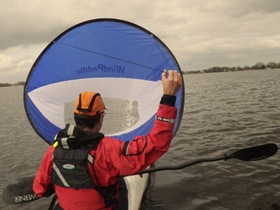 The Windpaddle Cruiser is a pop-up sail designed for use on kayaks, canoes, sit-on-tops and other small watercrafts. Playak experimented with the Windpladdle Cruiser on kayaks and canoes in the wind on the channels and lakes in the Green Heart of Holland.
The Windpaddle Cruiser is a pop-up sail designed for use on kayaks, canoes, sit-on-tops and other small watercrafts. Playak experimented with the Windpladdle Cruiser on kayaks and canoes in the wind on the channels and lakes in the Green Heart of Holland.
Introduction
I am not a sailor. I am a paddler. My first thought about sailing used to be: “boring”. I like to move and sweat when I am doing water sports. Nevertheless: even for me, paddling a kayak on the middle of a lake and feeling the force of the wind in my back, the idea of having a little sail at hand to benefit from the power of the wind is appealing.
Traditional designs for kayak sailing rigs don’t appeal to me: too much fuss with large constructions on the deck of the kayak. If at all, I want a basic solution: easy to set up and to stow away, not in the way when I am paddling, and no issues with stability: just a device to give me a welcome push when I am heading downwind. Windpaddle claims to offer such a device – I was curious enough to test the Windpaddle.
Design
The Windpadlle sail is a circular, spherical design. The shape reminds one of an umbrella. It’s much tougher than an umbrella though: no vulnerable tubes, stretchers and ribs are used on this sail.
The sail is supported by a circular, laminated, elastic perimeter batten. This batten can be twisted and bended and allows the sail to be stored into thirds. The sail itself is made of rip-stop polyester sailcloth. In the center panel of the sail is a horizontally oriented clear window.
The bottom of the Windpaddle feutures a deck mounting system composed of two bungees with hooks to clip the sail to the boat. On the top of the sail (in the 10 and 2 hours position) a continuous sheet is fastened to raise and hold the sail.
There exist 2 versions of the Windpaddle sail. Playak tested the the Windpladdle Cruiser in 2008, and this is the larger version. When deployed, the diameter of the Cruiser sail is about 1.50 meter (appr. 5ft), and when folded the sail forms a package with a diameter of 50 cm (20”) and a height of 5-6 cm (2”). The weight of the Windpaddle sail (the sail complete with the sewn in batten, the sheets and the deck mounting-bungees and clips) is about 700 grams (25oz).
The used materials are light, yet solid and durable. Bending the batten is perhaps exciting in the beginning, but the initial fear to break it proved to be unnecessary: the batten is solid and always returns to its original shape.
Included in the package of the Windpaddle Sail is an instructional DVD, adn the Windpaddle website http://www.windpaddle.com/ offers good resources with FAQs, videos and reviews of the sail.
Set-up
Mounting the Windpaddle on the test kayaks and canoes was a matter of seconds or at least less than a minute. No modifications on the kayak were required. The sail was mounted on an expedition sea kayak. I clipped the sail to the existing deck lines in front of the cockpit and stored the folded sail under the decklines. This will work on most touring and sea kayaks.
Stowed on the front deck the folded sail didn’t protrude on the sides of the kayak, but it did interfere with a high-angle paddling style. The sail was a bit too large for this particular kayak. For kayaks the smaller Windpaddle-Adventure sail will mostly be the better choice. Windpaddle recommends the Cruiser sail for larger double-kayaks and for canoes. On wider sit-on-tops and touring kayaks the Cruiser sail might fit. Try it out.
On most canoes, the size of the packed Cruiser sail is no issue. Playak tested the sail on a solo and a double canoe. On the canoes there were also no modifications needed to attach the sail: just clip it on a thwart or a seat: the mounting system of the sail is very adaptive. The best position for the sail turned out to be close to the bow.
Handling
Before going out on the water I practiced coiling, folding and storing the sail on land. Once you get the hang of it, the folding process is very intuitive, but for me it took multiple attempts to fold and coil the sail in thirds. My friends digged it faster than I did. It’s a matter of spatial visualization ability. Men on average are said to have a higher spatial intelligence than women. But I am the proof of the contrary. For people like me, watching the DVD instructions helped a lot!
With the sail stowed on the deck of the kayak I got out on the water. Launching the sail was a matter of seconds: I released it from under the deck lines and it popped up automatically. I grasped the sheet of the sail, held it up and in a eyewink the wind filled the sail: I was sailing! The whole process turned out to be very intuitive. I soon noticed that by lowering the sail I could depower it, by pulling the sheet and setting the sail more vertical it caught more wind – more power and the speed increased. Surprisingly stability proved to be no issue at all, even with occasional gusts from the side. The kayak tracked quit well with the sail, but it needs a rudder for directional stability. Since this kayak didn’t have a rudder I used the paddle to steer. The paddle is the best rudder you can get when you’re familiar with kayak techniques like edging the kayak and a stern rudder. But now things got tricky: I needed 2 hands to hold the paddle, and at least one hand (better 2?) to hold the sheet of the Windpaddle. Where is the extra hand?! As you can see in some of the pictures: I did put the sheet of the sail behind my neck. It may look ridiculous, but it worked quit well (a slightly thicker sheet, or some padding on the sheet would be more comfortable). On later attempts, after having watched the instruction DVD once more, I figured out how to hold the paddle and the sail at the same time, but I do need more practice to get really skilled in this. A rudder on the kayak will definitely make handling easier.
To stop sailing: just let the sheet go and the sail flattens. After the practice on land coiling, folding and storing the sail on the water is very manageable, within half a minute the sailing craft is a kayak again. In rougher water, folding the sail can be more of a challenge, but as long as you would normally be able to stay upright in your kayak without bracing, it’s no problem.
In the canoe the handling of the sail was comparable, perhaps even a bit easier. The felt freedom of movement was larger in the canoe. And the combination of a paddle rudder and the Windpaddle sheet felt more natural in the (solo) canoe than in the solo kayak. In the double Canoe the tasks can be split up: the foremast man handles the Windpaddle sail and the helmsman steers with the paddle.
The test conditions varied from a Light Breeze (= 2 Bft.) to beginning of a fresh Breeze (= lower part of 5 Bft.) . The sailing worked best for me in 3-4 Bft, in these range of winds the kayak and canoe picked up a speeds of 10-12 kmh (6-7 mph), in the upper part of 4 Bft even a bit faster. Effortlessly I cruised faster downwind than I could ever have paddled in these conditions!
The Windpaddle is a downwind sail, it does also work with the wind coming from an angle at the side, but then you are seriously drifting sideways. You can forget about cruising upwind.
Conclusion
The Windpaddle offered this paddler a lot of sailing fun. Without any serious sailing experience I sailed within minutes. Most important for me is the versatility of the Windpaddle. You can use it on any craft and it doesn’t turn a kayak or canoe into a complex, heavy sailing craft (which I would end up sailing instead of paddling). The boats stay real kayaks and canoes, I can paddle them like I always did, and when I want I can catch the wind with the Windpaddle. I didn’t know before that sailing can be so uncomplicated ;-). It is great to experience how a simple breeze moves you across the water faster than you can paddle. Sailing is fun!
Pros
- No modifications needed on the kayak
- No need for permanent mounting
- Easy to move from one boat to another
- Light and compact, portable – easy to store on board when not in use
- Intuitive and simple handling
- No noticeable influence on the stability of the boat
- Effective: only a light breeze needed to get the boat running
- Safe: just let the sheet go and the sail depowers
Cons
- The sheet of the Windcruiser sail is rather thin: a thicker line would be more comfortable to hold;
Advice
- The Windpaddle Cruiser sail is good for canoes and large double-kayaks. For solo-kayaks Windpadlle offers the smaller Adventure-sail, which is less likely to interfere with paddling when it’s stored on the deck of the kayak.
For Playak,
Hans Heupink
Login to post here



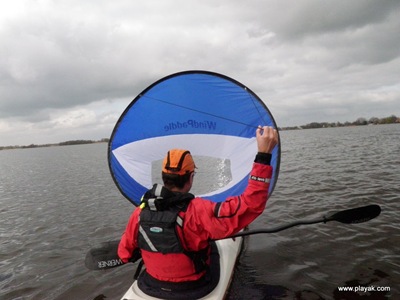
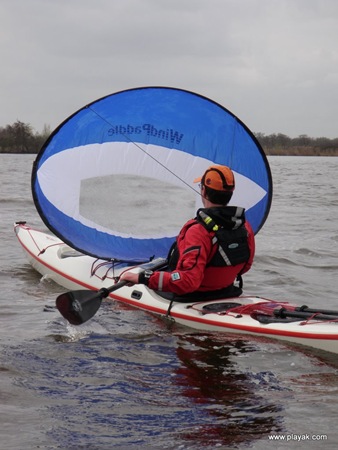
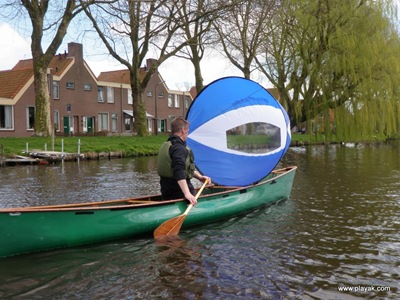
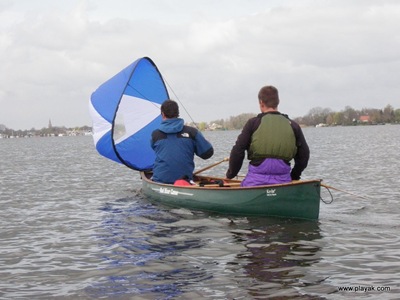


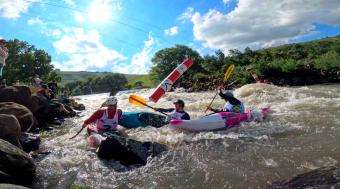








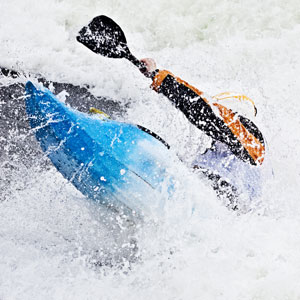 Get for free:
Get for free:








